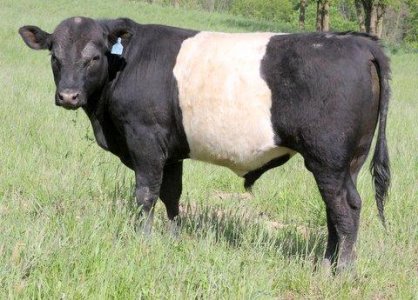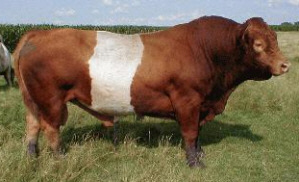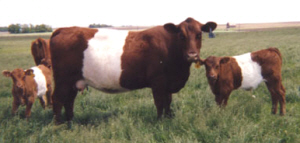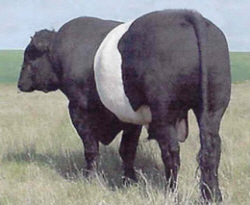Not familiar with this breed. What are the advantages and disadvantages?
Here is a little "Copy & Paste" history on the BueLingo breed:
The Buelingo was created in the USA in the 70's when a successful cattleman named Russ Bueling had the idea for a new breed that was belted and fit the requirements of the beef industry.
From Buelings idea a group of dedicated cattlemen including Alfred Ostrum and Russ Danielson (a Professor of Animal Science at North Dakota State University) lay the ground work, through careful selection and attention to detail the Buelingo emerged.
In the beginning a group of 14 commercial cows from the Bueling herd were registered as the initial foundation herd. The females were born from 1970 through 1979 and represented strong Shorthorn genetic influence. The future contribution of these females to the breed was limited. Records indicate only two of the 14 females produced a total of five calves that were registered.
A significant influence on establishing BueLingo breed type resulted from the progeny of belted females acquired by Flying Cross from the Sieker, Spykerboer and Ostrum herds. Many of the acquired females were mated to FX Freightrain BCS #40. Freightrain was sired by Davie B of Tillamook and his dam was Vickerman Hill Supreme, both parents were registered in the Dutch Belted Association. The influence of Freightrain on the breed was very important in establishing the consistent belting pattern as well as the growth and maternal characteristics of his offspring. His first calves were born in the Bueling herd in 1983. Subsequently, eighty-eight Freightrain sons and daughters were registered through the 1987 calving year by the Bueling's and eight additional calves were later registered by the Monson's from Wisconsin.
Freightrain provided great genetics as he was long, had smooth shoulders, large testicles, sound foot and was calm in personality. His progeny had strong reproductive attributes for early puberty, minimal calving difficulty, high conception rates, tight udders and large testicles.
Soon after the first Freightrain progeny were born it was noticed that added thickness and muscling were needed if the breed was meet industry standards. To obtain the necessary trait, semen from a registered Chianina bull called Yuma was acquired. He was thick, moderate framed and mild mannered.
One bull (Chilingo of Flying Cross) and two heifers (Yumalingo and Kikanina of Flying Cross) sired by Yuma were subsequently registered. The influence of Freightrain and Yuma set the stage for breed expansion as all the needed production and product traits seemed to be in place.
The BueLingo is a composite breed, though not a specific "per cent" mix like the Brangus or Santa Gertrudis. Nor are the BueLingo the result of serial event breedings as are the Murray Grey. The distinctive belt is largely derived from the Dutch Belt dairy cattle. The early BueLingo borrowed genetics from the Scotch Highland, the Belted Galloway, the Angus, the Limousin, and the Shorthorn cattle. The prominent early influence of the Angus, Limousin, and Shorthorn persists among the current examples of the breed today.
The Buelingo is an attractive breed, they are black or cherry red with a white belt and they can be either horned or polled. They are moderate in size between frame size 5 and 6 , the mature bulls weighing approximately 1400 to 1800lbs. and the cows 1000 to 1200 lbs. The Buelingo Society has set a goal for the 'Choice' market heifers and steers to be at least 1100lbs at 18 months old, this is being used as a guideline for selection to keep the breed at its best.
Birth weights typically vary between 65-80 pounds and calves should wean at 50% of the weight of the dam. BueLingo cows are extremely fertile and reach puberty at an early age. They are known for their docile dispositions, and for their ample supply of rich milk.
- High fecundity
- Strong libido
- Consistent calving weights
- Vigourous calves
- Rapid maturation rates
- Excellent maternal instincts
- Management friendly
- Carcass quality
Feed conversion ratios are usually less than six with daily gains in the 3.5 lbs. per day range (on 12% protein rations, with free choice hay). At the completion of the feed test, yearling bulls typically have less than 0.3 in. back fat; rib eye area index in these animals is usually greater than one. Modest marbling has been accompanied by excellent taste.
The Buelingo is mainly produced in the USA and Canada.
References (the above information was cited from the following sites)
www.buelingo.com
www.buelingo.net
www.krullcrest.com


![20220821_154928[1].jpg](https://data.www.cattletoday.com/attachments/19/19394-df8e1f7d47cad1dcf380d2bb4707f34f.jpg)
![20220821_155039[1].jpg](https://data.www.cattletoday.com/attachments/19/19395-d7a861fe6c5a8523b5d57564657b1de8.jpg)
![20220816_184217[1].jpg](https://data.www.cattletoday.com/attachments/19/19396-bd635d71b4123e81217fc4d4150f1020.jpg)
![20220830_184529[1].jpg](https://data.www.cattletoday.com/attachments/19/19397-61c030aabc09a1339c8c44944e3a3175.jpg)
![20220327_185809[1].jpg](https://data.www.cattletoday.com/attachments/19/19398-ae780d2a30d0456eeb45dbd69244c842.jpg)
![20220816_184213[1].jpg](https://data.www.cattletoday.com/attachments/19/19399-c7bba324b222bebfbc0025ff03d892a6.jpg)
![20220725_060551[1].jpg](https://data.www.cattletoday.com/attachments/19/19400-d361007f727cd55843a605eba06cb721.jpg)


